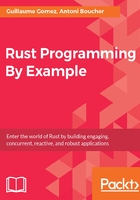
Playing with images
Just like textures, we need to initialize the image context. Now that we've activated the image feature, we can call the linked functions and import them. Let's add some new imports:
use sdl2::image::{LoadTexture, INIT_PNG, INIT_JPG};
Then we create the image context:
sdl2::image::init(INIT_PNG | INIT_JPG).expect("Couldn't initialize
image context");
Now that the context has been initialized, let's actually load the image:
let image_texture =
texture_creator.load_texture("assets/my_image.png") .expect("Couldn't load image");
A few explanations for the preceding code:
load_texture takes a file path as an argument. Be very careful with paths, even more when they're relative!
After that, it's just like we did with other textures. Let's put our image into our Window's background:
canvas.copy(&Image_texture, None, None).expect("Render failed");
To sum everything up, here's what your project's folder should look like now:
|- your_project/
|
|- Cargo.toml
|- src/
| |
| |- main.rs
|- assets/
|
|- my_image.png
And that's it!
Here's the full code in case you missed a step:
extern crate sdl2; use sdl2::pixels::Color; use sdl2::event::Event; use sdl2::keyboard::Keycode; use sdl2::render::TextureCreator; use sdl2::image::{LoadTexture, INIT_PNG, INIT_JPG}; use std::time::Duration; pub fn main() { let sdl_context = sdl2::init().expect("SDL initialization
failed"); let video_subsystem = sdl_context.video().expect("Couldn't
get SDL video subsystem"); sdl2::image::init(INIT_PNG | INIT_JPG).expect("Couldn't
initialize
image context"); let window = video_subsystem.window("rust-sdl2 image demo", 800,
600) .position_centered() .opengl() .build() .expect("Failed to create window"); let mut canvas = window.into_canvas().build().expect("Failed to
convert window into canvas"); let texture_creator: TextureCreator<_> =
canvas.texture_creator(); let image_texture =
texture_creator.load_texture("assets/my_image.png") .expect("Couldn't load image"); let mut event_pump = sdl_context.event_pump().expect("Failed to
get SDL event pump"); 'running: loop { for event in event_pump.poll_iter() { match event { Event::Quit { .. } | Event::KeyDown { keycode: Some(Keycode::Escape), .. }
=> { break 'running }, _ => {} } } canvas.set_draw_color(Color::RGB(0, 0, 0)); canvas.clear(); canvas.copy(&image_texture, None, None).expect("Render
failed"); canvas.present(); ::std::thread::sleep(Duration::new(0, 1_000_000_000u32 / 60)); } }
In my case, it gives the following output:

Figure 2.6
Now that we know how to make Windows and play with events and textures, let's see how to save and load high scores from files!